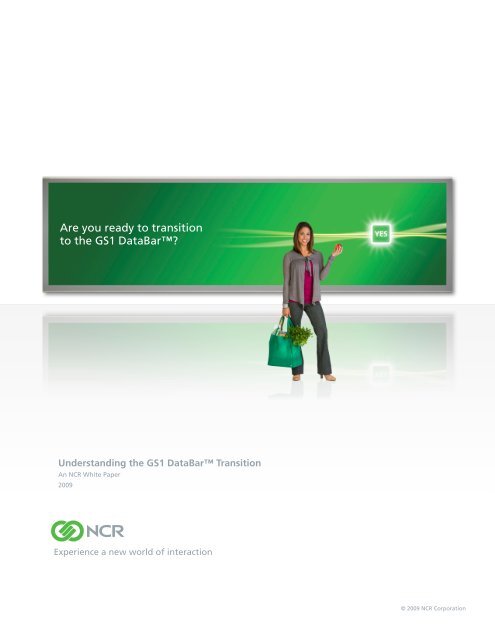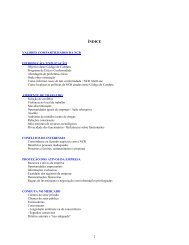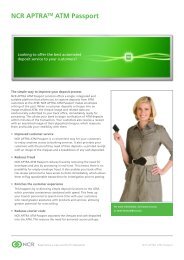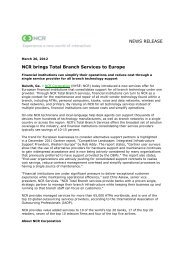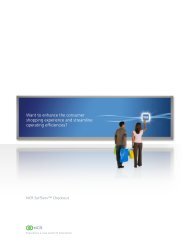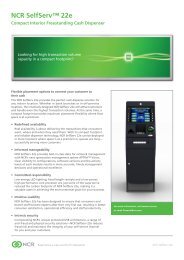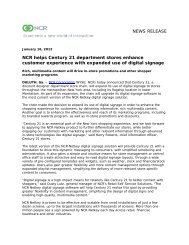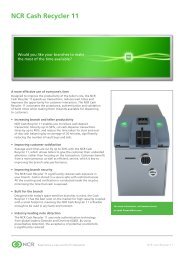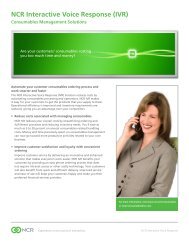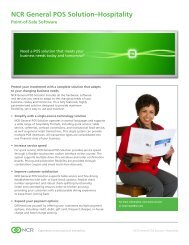Understanding the GS1 DataBar Transition, an NCR White Paper
Understanding the GS1 DataBar Transition, an NCR White Paper
Understanding the GS1 DataBar Transition, an NCR White Paper
Create successful ePaper yourself
Turn your PDF publications into a flip-book with our unique Google optimized e-Paper software.
Are you ready to tr<strong>an</strong>sition<br />
to <strong>the</strong> <strong>GS1</strong> <strong>DataBar</strong>?<br />
<strong>Underst<strong>an</strong>ding</strong> <strong>the</strong> <strong>GS1</strong> <strong>DataBar</strong> <strong>Tr<strong>an</strong>sition</strong><br />
An <strong>NCR</strong> <strong>White</strong> <strong>Paper</strong><br />
2009<br />
Experience a new world of interaction<br />
© 2009 <strong>NCR</strong> Corporation
Executive summary 1<br />
The <strong>GS1</strong> <strong>DataBar</strong> (formerly called Reduced Space<br />
Symbology RSS) is <strong>the</strong> first new bar code symbology<br />
introduced worldwide to retail since <strong>the</strong> introduction<br />
of <strong>the</strong> Europe<strong>an</strong> Article Number (EAN) format in 1977.<br />
As of J<strong>an</strong>uary 1, 2011, all m<strong>an</strong>ufacturer coupons in <strong>the</strong><br />
United States <strong>an</strong>d C<strong>an</strong>ada will fully tr<strong>an</strong>sition to <strong>the</strong><br />
<strong>GS1</strong> <strong>DataBar</strong> symbology. Although <strong>the</strong> coupon issue is<br />
unique to USA <strong>an</strong>d C<strong>an</strong>ada, <strong>the</strong> general <strong>GS1</strong> <strong>DataBar</strong><br />
date for countries outside of <strong>the</strong> United States <strong>an</strong>d<br />
C<strong>an</strong>ada has been extended to allow for individual<br />
country-level compli<strong>an</strong>ce as late as J<strong>an</strong>uary 1, 2014.<br />
Coupons are not part of <strong>an</strong>y bar code tr<strong>an</strong>sition<br />
outside of <strong>the</strong> USA <strong>an</strong>d C<strong>an</strong>ada.<br />
This tr<strong>an</strong>sition will be highly beneficial for everyone<br />
in <strong>the</strong> industry, including <strong>the</strong> consumer. But, like <strong>an</strong>y<br />
ch<strong>an</strong>ge in technology, it will require some preparation.<br />
Bar code history<br />
In 1949, Joseph Woodl<strong>an</strong>d applied for a patent, which<br />
was gr<strong>an</strong>ted in 1952, for <strong>the</strong> first linear bar code. With<br />
<strong>the</strong> introduction of a technology that could ch<strong>an</strong>ge<br />
<strong>the</strong> face of retail globally, a set of st<strong>an</strong>dards would be<br />
needed to make <strong>the</strong> bar code a success. Woodl<strong>an</strong>d’s bar<br />
code was not <strong>the</strong> code that eventually became known<br />
as <strong>the</strong> Universal Product Code (UPC), but it created<br />
<strong>the</strong> thought process which eventually led to meetings<br />
between <strong>the</strong> Grocery M<strong>an</strong>ufacturers Association (GMA)<br />
<strong>an</strong>d <strong>the</strong> National Association of Food Chains in 1969 to<br />
investigate this need for uniformity.<br />
These meetings led to <strong>the</strong> formation of <strong>the</strong> Uniform<br />
Grocery Product Code Council (UGPCC) which first met<br />
in 1972. Over <strong>the</strong> years <strong>the</strong> council became <strong>the</strong> Uniform<br />
Code Council (UCC) <strong>an</strong>d, after merging with EAN in<br />
2005, fell under <strong>the</strong> umbrella name of <strong>GS1</strong>. When<br />
relev<strong>an</strong>t, <strong>the</strong> United States arm of <strong>GS1</strong> is referred to as<br />
<strong>GS1</strong> US <strong>an</strong>d maintains a separate website from that of<br />
<strong>GS1</strong>. The actual bar code administered in North America<br />
was always known as <strong>the</strong> UPC. The most common<br />
12-digit version is still known as UPC-A.<br />
Bar codes <strong>an</strong>d coupons<br />
The introduction of bar codes into retail in 1974<br />
eventually paved <strong>the</strong> way for today’s sc<strong>an</strong>nable<br />
coupons, although coupons were never part of <strong>the</strong><br />
original intention for UPC bar code technology. The<br />
coupon bar code didn’t even exist until 1985, when it<br />
became <strong>the</strong> UPC-A Number System 5. (Number System 5<br />
refers to <strong>the</strong> fact that <strong>the</strong> UPC-A m<strong>an</strong>ufacturer coupon<br />
guideline specifies “5” as <strong>the</strong> leading digit.)<br />
Since coupons were not in <strong>the</strong> original pl<strong>an</strong> for bar<br />
codes, <strong>the</strong>re has been a const<strong>an</strong>t need to modify <strong>the</strong><br />
system to accommodate <strong>the</strong> growing adoption of<br />
couponing. Because of this, <strong>the</strong> UPC coupon bar code<br />
has evolved a great deal since its humble beginnings.<br />
•<br />
•<br />
•<br />
1985 – Original UPC-A-based coupon released.<br />
1997 – As more m<strong>an</strong>ufacturers applied for IDs,<br />
<strong>the</strong> realization sets in that <strong>the</strong> UPC-A will run<br />
out of digits in <strong>the</strong> future. A second bar code<br />
must now be added to coupons <strong>the</strong> Extended<br />
Coupon Code, implemented in <strong>an</strong>o<strong>the</strong>r bar<br />
code symbology called Code 128. From 1997<br />
on, coupons carry both UPC-A <strong>an</strong>d Code 128.<br />
2005 – From 1997 to 2005, <strong>the</strong> m<strong>an</strong>ufacturer<br />
ID portion of <strong>the</strong> UPC information grew from<br />
6 digits to as m<strong>an</strong>y as 10. Couponing again<br />
became a victim of <strong>the</strong> UPC’s success.<br />
Since <strong>the</strong>n, <strong>the</strong> system has been meticulously m<strong>an</strong>aged<br />
to avoid issues until a new bar code solution could be<br />
introduced. The <strong>GS1</strong> <strong>DataBar</strong> is <strong>the</strong> latest <strong>an</strong>d greatest<br />
evolution of <strong>the</strong> bar code <strong>an</strong>d coupon system.<br />
<strong>NCR</strong> Confidential Proprietary
Compli<strong>an</strong>ce tiers<br />
Retailers today should be concerned about three major<br />
tiers of bar code symbology <strong>an</strong>d bar code processing<br />
compli<strong>an</strong>ce.<br />
1. 2005 Sunrise Compli<strong>an</strong>ce (<strong>an</strong>d GTIN)<br />
2. <strong>GS1</strong> <strong>DataBar</strong> 2010 Sunrise Compli<strong>an</strong>ce<br />
3. <strong>GS1</strong> <strong>DataBar</strong> 2011 Coupon Compli<strong>an</strong>ce<br />
As new levels of compli<strong>an</strong>ce are introduced, <strong>the</strong> newer<br />
encompasses <strong>the</strong> st<strong>an</strong>dards for <strong>the</strong> predecessor, with<br />
<strong>GS1</strong> <strong>DataBar</strong> Compli<strong>an</strong>ce being <strong>the</strong> latest <strong>an</strong>d most<br />
encompassing.<br />
2005 Sunrise Compli<strong>an</strong>ce<br />
Because of rapid exp<strong>an</strong>sion <strong>an</strong>d <strong>the</strong> need for a single<br />
global retail bar code st<strong>an</strong>dard, <strong>GS1</strong> in 1997 <strong>an</strong>nounced<br />
<strong>the</strong> 2005 Sunrise initiative. This new initiative stated<br />
that by J<strong>an</strong>uary 1, 2005, all comp<strong>an</strong>ies in <strong>the</strong> United<br />
States <strong>an</strong>d C<strong>an</strong>ada must be capable of processing EAN-8<br />
<strong>an</strong>d EAN-13 symbologies, in addition to <strong>the</strong> st<strong>an</strong>dard<br />
12-digit UPC.<br />
Prior to 2005 Sunrise, trade item vendors outside <strong>the</strong><br />
United States <strong>an</strong>d C<strong>an</strong>ada who were using EAN-8 <strong>an</strong>d<br />
EAN-13 symbology had to re-label <strong>the</strong>ir products with<br />
UPCs to be sold in <strong>the</strong> U.S. This me<strong>an</strong>t applying for U.S.<br />
<strong>an</strong>d C<strong>an</strong>adi<strong>an</strong> bar codes with <strong>the</strong> UCC, at additional<br />
expense <strong>an</strong>d time.<br />
After 2005 Sunrise, all products c<strong>an</strong> now be sc<strong>an</strong>ned<br />
<strong>an</strong>d processed globally without <strong>the</strong> need to re-label.<br />
To be 2005 Sunrise-compli<strong>an</strong>t, retailers must be able<br />
to sc<strong>an</strong> <strong>an</strong>d process UPC as well as EAN-8 <strong>an</strong>d EAN-13.<br />
They must also be able to store <strong>the</strong>se symbols in <strong>the</strong>ir<br />
entirety (<strong>GS1</strong> recommends also being able to store <strong>the</strong><br />
check digit). In addition, parsing <strong>the</strong> M<strong>an</strong>ufacturer<br />
ID (<strong>GS1</strong> M<strong>an</strong>ufacturer Prefix) is not allowed, nor is<br />
assigning UPC numbers with lead digits of 1, 6, 7, 8,<br />
or 9 for internal purposes.<br />
GTIN<br />
In addition to <strong>the</strong> 2005 Sunrise <strong>an</strong>d <strong>GS1</strong> <strong>DataBar</strong> 2010<br />
Sunrise Compli<strong>an</strong>ce, retailers should underst<strong>an</strong>d one<br />
additional layer of compli<strong>an</strong>ce when looking into<br />
adopting <strong>the</strong> <strong>GS1</strong> <strong>DataBar</strong> Global Trade Item Numbers<br />
(GTIN) compli<strong>an</strong>ce. GTIN is a database st<strong>an</strong>dard,<br />
<strong>an</strong>d not on <strong>the</strong> <strong>GS1</strong> <strong>DataBar</strong> 2010 Sunrise timeline,<br />
but could be very beneficial to retailers for m<strong>an</strong>aging<br />
<strong>the</strong> new bar codes. GTIN is <strong>an</strong> umbrella term used<br />
to describe <strong>the</strong> entire family of data structures that<br />
identifies trade items (products <strong>an</strong>d services). These<br />
data structures include <strong>the</strong> data encoded in UPC,<br />
EAN-8, EAN-13, <strong>an</strong>d 14-digit case-level bar codes.<br />
The introduction of GTIN compli<strong>an</strong>ce brings a need to<br />
store 14-digit bar code information. These 14-digit bar<br />
codes are not intended for retail point of sale (POS) at<br />
this time, but c<strong>an</strong> be found in <strong>the</strong> supply chain where<br />
bulk package identification is necessary. In a GTINcompli<strong>an</strong>t<br />
environment, <strong>the</strong> 14-digit bar codes are<br />
right justified <strong>an</strong>d left padded with zeros.<br />
As mentioned, GTIN compli<strong>an</strong>ce is not currently a firm<br />
requirement for <strong>GS1</strong> <strong>DataBar</strong> 2010 Sunrise compli<strong>an</strong>ce,<br />
but it will become desirable as <strong>the</strong> system grows. The<br />
2010 implementation of <strong>GS1</strong> <strong>DataBar</strong> allows truncation<br />
to 13 digits since <strong>the</strong> first digit is always “0” at this<br />
time. However, this may not stay true for future<br />
implementations of <strong>GS1</strong> <strong>DataBar</strong>, <strong>an</strong>d 14 digits<br />
could become necessary.<br />
2<br />
<strong>NCR</strong> Confidential Proprietary
<strong>GS1</strong> <strong>DataBar</strong> 2010 Sunrise Compli<strong>an</strong>ce<br />
The new <strong>GS1</strong> <strong>DataBar</strong> format now allows for bar codes<br />
to be used on items too small for traditional UPC <strong>an</strong>d<br />
EAN. It also allows additional data to be included <strong>an</strong>d<br />
sc<strong>an</strong>ned at <strong>the</strong> POS for retailers that choose to take<br />
adv<strong>an</strong>tage of it.<br />
The new <strong>GS1</strong> <strong>DataBar</strong> format has several variations,<br />
but only four apply to general retail POS:<br />
1. Omnidirectional<br />
2. Omnidirectional Stacked<br />
3. Exp<strong>an</strong>ded<br />
4. Exp<strong>an</strong>ded Stacked<br />
The only difference between Omnidirectional <strong>an</strong>d<br />
Stacked Omnidirectional is that <strong>the</strong> data is now<br />
“stacked.” The same goes for <strong>the</strong> exp<strong>an</strong>ded version.<br />
Stacked formats allow for more data to be contained<br />
in a smaller <strong>an</strong>d more conveniently shaped space.<br />
<strong>GS1</strong> <strong>DataBar</strong> Omnidirectional lends itself to applications<br />
where items may be too small for traditional UPC bar<br />
codes, or where <strong>the</strong> traditional EAN/UPC bar codes<br />
have been truncated or reduced (shrunk) to fit <strong>the</strong><br />
small spaces, which degrades sc<strong>an</strong>ning speeds. The<br />
application most spoken of today is produce, <strong>an</strong>d this<br />
format is currently showing up in several major retailers<br />
with positive sc<strong>an</strong>ning <strong>an</strong>d accuracy results.<br />
<strong>GS1</strong> <strong>DataBar</strong> Exp<strong>an</strong>ded creates a whole new<br />
opportunity at POS, where lot numbers, expiration<br />
dates, unit weights, net weights <strong>an</strong>d o<strong>the</strong>r import<strong>an</strong>t<br />
data c<strong>an</strong> be h<strong>an</strong>dled <strong>an</strong>d reported in real time at POS.<br />
The example illustrated here contains <strong>an</strong> item number,<br />
lot number <strong>an</strong>d expiration date in <strong>an</strong> area similar in<br />
size to that used by a UPC-A:<br />
All of <strong>the</strong>se bar codes are available to be placed on<br />
produce items for general retail sale <strong>an</strong>d items within<br />
a retailer’s supply chain (e.g., case-ready meat) in North<br />
America as of J<strong>an</strong>uary 1, 2010 (<strong>GS1</strong> <strong>DataBar</strong> Sunrise).<br />
Individual industries will add <strong>the</strong>ir support by releasing<br />
application guidelines over time. Guidelines already<br />
exist for produce, variable measure (most commonly<br />
meat) <strong>an</strong>d coupons.<br />
<strong>GS1</strong> <strong>DataBar</strong> 2011 Coupon Compli<strong>an</strong>ce<br />
There are two very compelling reasons retailers must<br />
be ready to read <strong>an</strong>d process <strong>the</strong> data by <strong>GS1</strong> <strong>DataBar</strong><br />
Sunrise— coupons <strong>an</strong>d produce. Although <strong>the</strong> ch<strong>an</strong>ges<br />
coming to produce, th<strong>an</strong>ks to <strong>the</strong> <strong>GS1</strong> <strong>DataBar</strong> tr<strong>an</strong>sition,<br />
will be very beneficial to retailers, processing produce<br />
will not be m<strong>an</strong>datory. The same c<strong>an</strong>not be said for<br />
coupons. Being able to process coupons will be<br />
essential to all retailers.<br />
Recently, m<strong>an</strong>datory support for <strong>the</strong> new <strong>GS1</strong> <strong>DataBar</strong><br />
on coupons has been delayed until J<strong>an</strong>uary 1, 2011.<br />
However, this only extends <strong>the</strong> time available for<br />
coupons to carry <strong>the</strong> UPC-A coupon code alongside <strong>the</strong><br />
new <strong>GS1</strong> <strong>DataBar</strong>. After J<strong>an</strong>uary 1, 2011 <strong>the</strong> UPC-A will<br />
be removed <strong>an</strong>d only <strong>the</strong> <strong>GS1</strong> <strong>DataBar</strong> will remain.<br />
Coupons: Retailers will find that <strong>the</strong> new <strong>GS1</strong> <strong>DataBar</strong><br />
ch<strong>an</strong>ges <strong>the</strong> way <strong>the</strong>y currently accept <strong>an</strong>d redeem<br />
coupons. Also, it is import<strong>an</strong>t to know that coupon<br />
3<br />
<strong>NCR</strong> Confidential Proprietary
m<strong>an</strong>ufacturers are currently making <strong>the</strong> <strong>GS1</strong> <strong>DataBar</strong><br />
tr<strong>an</strong>sition, <strong>an</strong>d most are already well into <strong>the</strong> three-year<br />
pl<strong>an</strong> to convert.<br />
Currently, coupons are in a tr<strong>an</strong>sition period:<br />
Until 2008, coupons carried both <strong>the</strong> UPC-A <strong>an</strong>d Code<br />
128 Extended Coupon Code bar codes.<br />
From J<strong>an</strong>uary 2008 until June 2008, <strong>the</strong> Code 128<br />
bar code portion of <strong>the</strong> coupon was phased out <strong>an</strong>d<br />
replaced by <strong>the</strong> new <strong>GS1</strong> <strong>DataBar</strong>. The UPC-A portion<br />
remains.<br />
Starting J<strong>an</strong>uary 1, 2011, m<strong>an</strong>ufacturers will be allowed<br />
at <strong>the</strong>ir discretion to drop <strong>the</strong> remaining UPC bar code<br />
<strong>an</strong>d only print <strong>the</strong> new <strong>GS1</strong> <strong>DataBar</strong>. Following this<br />
optional tr<strong>an</strong>sition period, by June 2011, <strong>the</strong>y will be<br />
required to only print <strong>the</strong> <strong>GS1</strong> <strong>DataBar</strong>.<br />
So <strong>the</strong> question remains: C<strong>an</strong> this be ignored, <strong>an</strong>d c<strong>an</strong><br />
retailers process <strong>the</strong> coupons m<strong>an</strong>ually without <strong>the</strong><br />
need to sc<strong>an</strong>?<br />
The short <strong>an</strong>swer is, “no.” The nature of <strong>the</strong> new <strong>GS1</strong><br />
<strong>DataBar</strong> is to allow for growth, additional data, <strong>an</strong>d<br />
flexibility. As this format grows, coupons will become<br />
multifaceted <strong>an</strong>d more complex. A cashier today may<br />
be able to m<strong>an</strong>ually discount $0.90 from a purchase,<br />
but soon coupons will discount across multiple offers<br />
<strong>an</strong>d work in conjunction with multiple products <strong>an</strong>d<br />
multiple m<strong>an</strong>ufacturers’ IDs. This additional data allows<br />
for scenarios like, “Buying two of product A <strong>an</strong>d three<br />
of product B entitles you to a discount on product C.”<br />
A cashier will not be able to m<strong>an</strong>ually enter promotions<br />
of this complexity. The only solution will be to have <strong>the</strong><br />
ability to sc<strong>an</strong> <strong>the</strong> coupon <strong>an</strong>d let <strong>the</strong> POS solution do<br />
<strong>the</strong> work. Scenarios similar to this, where cashiers are<br />
unable to sc<strong>an</strong> <strong>GS1</strong> <strong>DataBar</strong> coupons, also increase <strong>the</strong><br />
temptation for cashiers to give products away in <strong>an</strong><br />
attempt to please <strong>the</strong> customer <strong>an</strong>d speed <strong>the</strong><br />
checkout process.<br />
Produce: Produce is <strong>the</strong> second compelling reason for<br />
retailers to adopt <strong>GS1</strong> <strong>DataBar</strong>, <strong>an</strong>d its introduction date<br />
is still J<strong>an</strong>uary 1, 2010. Although coupons present more<br />
of a m<strong>an</strong>datory need to comply, produce presents <strong>an</strong><br />
optional incentive to embrace <strong>the</strong> new bar code<br />
format, <strong>an</strong>d adoption is completely up to <strong>the</strong> retailer.<br />
The incentive is valuable, though, <strong>an</strong>d offers benefits<br />
that go directly to <strong>the</strong> bottom line.<br />
A 2001 study by <strong>NCR</strong>, <strong>the</strong> Food Marketing Institute<br />
(FMI) <strong>an</strong>d <strong>GS1</strong> (which was still <strong>the</strong> UCC at that time),<br />
at Dorothy L<strong>an</strong>e Market in Dayton, Ohio, was designed<br />
to evaluate how much produce revenue is lost at <strong>the</strong><br />
front end due to cashier misidentification. The study<br />
found that this loss accounts for almost 1 percent of<br />
total produce revenue. This holds especially true in<br />
high staff turnover environments where cashiers tend to<br />
memorize item codes as a method to increase checkout<br />
speed, such as <strong>the</strong> more general apple PLU 4103<br />
(Jonath<strong>an</strong> Apples). This becomes a real problem when<br />
retailers are losing revenue on items such as org<strong>an</strong>ics<br />
<strong>an</strong>d specialty produce.<br />
4<br />
<strong>NCR</strong> Confidential Proprietary
The new <strong>GS1</strong> <strong>DataBar</strong> format eliminates this loss by<br />
allowing cashiers—whe<strong>the</strong>r novice or experienced—<br />
to sc<strong>an</strong> produce instead of memorizing item codes.<br />
The FMI estimates that this could almost entirely<br />
address <strong>the</strong> 1 percent of produce revenue lost solely to<br />
misidentification using current h<strong>an</strong>d-entered methods.<br />
In addition to becoming a valuable resource to cashiers,<br />
<strong>the</strong> <strong>GS1</strong> <strong>DataBar</strong> also brings <strong>the</strong> same benefits to<br />
consumers who use <strong>the</strong> increasingly popular self-<br />
checkout solutions.<br />
What else does <strong>the</strong> <strong>GS1</strong> <strong>DataBar</strong> do?<br />
In addition to coupon <strong>an</strong>d produce benefits, <strong>the</strong> <strong>GS1</strong><br />
<strong>DataBar</strong> also c<strong>an</strong> carry Application Identifiers (AIs). AIs<br />
have been around for a long time, but this is <strong>the</strong> first<br />
time <strong>the</strong>y have made <strong>an</strong> appear<strong>an</strong>ce at <strong>the</strong> POS.<br />
An AI is <strong>an</strong> additional set of codes that help identify<br />
long streams of bar code data. They are traditionally<br />
found in warehousing <strong>an</strong>d shipping environments<br />
where sc<strong>an</strong>ners <strong>an</strong>d processors need to identify bulk<br />
qu<strong>an</strong>tities of goods.<br />
With <strong>GS1</strong> <strong>DataBar</strong> Exp<strong>an</strong>ded, this information c<strong>an</strong> now<br />
be stacked <strong>an</strong>d sc<strong>an</strong>ned at <strong>the</strong> POS. As retailers decide<br />
to implement AIs for <strong>the</strong>ir products <strong>an</strong>d applications,<br />
a variety of new data options become available at <strong>the</strong><br />
front end, such as net weight, price per unit, extended<br />
price <strong>an</strong>d even expiration dates for perishable goods.<br />
With <strong>the</strong> increasing focus on product safety <strong>an</strong>d<br />
traceability, <strong>the</strong> <strong>GS1</strong> <strong>DataBar</strong> lays <strong>the</strong> foundation<br />
not only for immediate automatic prevention of <strong>the</strong><br />
sale of old-dated fresh food at <strong>the</strong> POS, but also for<br />
<strong>the</strong> traceability st<strong>an</strong>dards <strong>an</strong>d networks now being<br />
developed.<br />
IMPORTANT: A note on <strong>the</strong> ch<strong>an</strong>ge to <strong>the</strong><br />
Coupon Sunrise Date<br />
On June 18, 2009, <strong>the</strong> Grocery M<strong>an</strong>ufacturer’s<br />
Association (GMA) <strong>an</strong>nounced that coupons would<br />
now have a “deferred implementation date of<br />
J<strong>an</strong>uary 1, 2011” ra<strong>the</strong>r th<strong>an</strong> <strong>the</strong> pl<strong>an</strong>ned date<br />
of J<strong>an</strong>uary 1, 2010. Keeping in mind that almost<br />
all m<strong>an</strong>ufacturer coupons already have <strong>the</strong> <strong>GS1</strong><br />
<strong>DataBar</strong> bar code printed, GMA added that <strong>the</strong><br />
“recommendation to defer implementation should not<br />
dissuade ready retailers that are eager to capitalize on<br />
<strong>the</strong> additional capabilities of <strong>the</strong> <strong>DataBar</strong> from beginning<br />
to sc<strong>an</strong> <strong>the</strong> new symbol on or before J<strong>an</strong>uary 1, 2010.”<br />
It is import<strong>an</strong>t to underst<strong>an</strong>d that <strong>the</strong> new date has not<br />
been extended to defer <strong>the</strong> printing of <strong>the</strong> <strong>GS1</strong> <strong>DataBar</strong><br />
on coupons, but to allow <strong>the</strong> UPC-A bar code to remain<br />
alongside <strong>the</strong> <strong>GS1</strong> <strong>DataBar</strong> for a longer period of time.<br />
Although <strong>the</strong> date extension offers those impacted by<br />
<strong>the</strong> <strong>GS1</strong> <strong>DataBar</strong> tr<strong>an</strong>sition <strong>an</strong> additional year to prepare<br />
for <strong>the</strong> ch<strong>an</strong>ge, <strong>the</strong>re is a restriction in <strong>the</strong> current coupon<br />
implementation.<br />
That restriction is: When <strong>the</strong> interim coupon was<br />
implemented in 2008, retailers who were not <strong>GS1</strong><br />
<strong>DataBar</strong> compli<strong>an</strong>t lost <strong>the</strong> ability to sc<strong>an</strong> <strong>the</strong><br />
expiration date at <strong>the</strong> point of sale.<br />
As mentioned earlier, <strong>the</strong> first ch<strong>an</strong>ge to coupons in<br />
1997 was <strong>the</strong> addition of <strong>the</strong> Code 128 Extended Coupon<br />
Code that accomp<strong>an</strong>ied <strong>the</strong> original UPC-A bar code on<br />
<strong>the</strong> coupon. The Code 128 Extended Coupon Code had<br />
<strong>the</strong> ability to contain <strong>the</strong> expiration date <strong>an</strong>d <strong>the</strong>refore<br />
allowed this data to be sc<strong>an</strong>ned <strong>an</strong>d processed at <strong>the</strong><br />
point-of-sale.<br />
Remember that in 2008 <strong>the</strong> interim coupon was<br />
introduced, <strong>an</strong>d <strong>the</strong> Code 128 Extended Coupon<br />
Code was eliminated in favor of using <strong>the</strong> <strong>GS1</strong> <strong>DataBar</strong><br />
Coupon Code beside <strong>the</strong> original UPC-A. Since <strong>the</strong> UPC-A<br />
bar code c<strong>an</strong>not support expiration dates, <strong>the</strong> only way<br />
for retailers to now process this additional information<br />
at <strong>the</strong> sc<strong>an</strong>ner is by having <strong>the</strong> ability to sc<strong>an</strong> <strong>an</strong>d process<br />
<strong>the</strong> <strong>GS1</strong> <strong>DataBar</strong> bar code on coupons.<br />
The original 1985 UPC-A coupon structure:<br />
Figure 1: U.P.C. Coupon Code<br />
Not to scale<br />
5 12345 67890<br />
0<br />
coupon<br />
NSC<br />
family<br />
code<br />
m<strong>an</strong>ufacturer ID<br />
value<br />
code<br />
check<br />
digit<br />
5<br />
<strong>NCR</strong> Confidential Proprietary
Summary<br />
<strong>GS1</strong> <strong>DataBar</strong> 2010/2011 Sunrise brings a new wave<br />
of sc<strong>an</strong>ning <strong>an</strong>d couponing options that have never<br />
been seen before in retail. The benefits will reach<br />
everyone from m<strong>an</strong>ufacturers <strong>an</strong>d retailers to individual<br />
consumers. It is vital that retailers underst<strong>an</strong>d what<br />
it takes to be compli<strong>an</strong>t, especially as <strong>the</strong> deadline<br />
approaches.<br />
Retailers who initiate <strong>the</strong> <strong>GS1</strong> <strong>DataBar</strong> tr<strong>an</strong>sition early<br />
will benefit immediately from this new technology.<br />
To learn more about starting your own <strong>GS1</strong> <strong>DataBar</strong><br />
tr<strong>an</strong>sition, or to find out if your existing technology <strong>an</strong>d<br />
software are compli<strong>an</strong>t, visit www.gs1us.org or contact<br />
us at retail@ncr.com.<br />
6<br />
<strong>NCR</strong> Confidential Proprietary
Why <strong>NCR</strong>?<br />
With over 125 years of retail experience, <strong>NCR</strong> is a<br />
leading global provider of assisted- <strong>an</strong>d self-service<br />
solutions. We help our clients around <strong>the</strong> world improve<br />
<strong>the</strong>ir customer interactions, implement ch<strong>an</strong>ge quickly<br />
<strong>an</strong>d proactively, <strong>an</strong>d tr<strong>an</strong>sform <strong>the</strong>ir businesses to<br />
become leaders <strong>an</strong>d ch<strong>an</strong>ge agents.<br />
We c<strong>an</strong> help you, too.<br />
<strong>NCR</strong> Corporation<br />
1700 S. Patterson Blvd<br />
Dayton, Ohio 45479<br />
USA<br />
For more information on <strong>NCR</strong>,<br />
please visit:<br />
www.ncr.com/retail<br />
Experience a new world of interaction<br />
<strong>NCR</strong> continually improves products as new technologies <strong>an</strong>d components become available. <strong>NCR</strong>, <strong>the</strong>refore, reserves <strong>the</strong> right to ch<strong>an</strong>ge specifications without prior notice.<br />
All features, functions <strong>an</strong>d operations described herein may not be marketed by <strong>NCR</strong> in all parts of <strong>the</strong> world. Consult your <strong>NCR</strong> representative or <strong>NCR</strong> office for <strong>the</strong> latest information.<br />
<strong>NCR</strong> is a registered trademark or trademark of <strong>NCR</strong> Corporation in <strong>the</strong> United States <strong>an</strong>d/or o<strong>the</strong>r countries. All br<strong>an</strong>d <strong>an</strong>d product names appearing in this<br />
document are trademarks, registered trademarks or service marks of <strong>the</strong>ir respective holders.<br />
© 2009 <strong>NCR</strong> Corporation Patents Pending EB10152-0609 www.ncr.com


